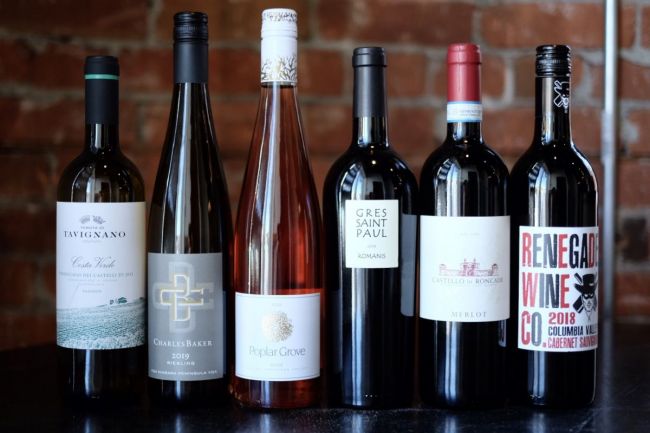| Hello everyone, your April edition of Vine Arts Wine Club will be available for pickup from both locations on Thursday, April 1st. This months wine bag includes two Canadian wines, two Italian wines, a wine from the south of France, and a burger ready Cab Sauv from Washington State. Hope you enjoy! Cheers! |
| 2018 Tenuta di Tavignano Costa Verde Verdicchio dei Castelli di Jesi Classico |
Marche, Italy $23.64
Verdicchio dei Castelli di Jesi is a white wine appellation located in the Italian region of Marche. Situated on the eastern side of the Apennine mountains, Marche is bordered to the north by Emilia-Romagna, to the south by Abruzzo, and to the west by Umbria. The borders of the Verdicchio dei Castelli di Jesi DOC were drawn to include the rolling landscape that surrounds the town of Jesi. The “Castelli” in the title comes from the many fortified villages that dot the landscape in the area. Sitting not far from the cool waters of the Adriatic and crossed by the Cesano and Esino river, the climate is mostly temperate. The Classico area of Verdicchio dei Castelli di Jesi is devoted to vineyards in the oldest area of the appellation.
What
Translated as the "little green one", Verdicchio is notably fresh, highly acidic and herbaceous in character. It is often considered to be one of Italy’s greatest and most versatile white grape varieties. Known in Veneto as Trebbiano di Soave, it’s thought to have been brought to Marche by Venetians who were fleeing a plague. Confusingly, DNA studies have also found that it’s identical to Trebbiano Valtanesi and Peverella. Taking into account its numerous names, Verdicchio is one of Italy’s most planted grapes.
The Costa Verde is made from 100% Verdicchio that was hand harvested and traditionally fermented with temperature control.
Who
The 230 hectare Tenuta di Tavignano estate is located in the countryside of Cingoli, between the Apennine mountains and the Adriatic sea in the region of Marche. The winery was purchased in 1975 by Stefano Aymerich di Laconi and his wife Beatrice Lucangeli. During the 1990’s the couple replanted their vineyards in Castelli di Jesi Classico. There are 30 hectares of Verdicchio, Montepulciano, Sangiovese and other native varieties. Today, Ondine de la Feld, Stefano’s niece, supports her uncle in the management of the winery.
Taste
Pale straw yellow in appearance with a green tinge, the Tenuta di Tavignano Costa Verde is a youthful expression of Verdicchio dei Castelli di Jesi. The palate is light bodied with a slight oily texture. Acidity is high. The “green” personality is complemented by notes of fresh lemons, pink grapefruit, sea salt, and almond paste. On the finish there is fine minerality and a tinge of bitterness. Snappy and refreshing, it’s a great match for a plate of frittura di paranza (mixed, Italian-style fried seafood).
| 2019 Charles Baker CBR Riesling |
Niagara Peninsula, Canada $23.60
Although here in western Canada we tend to hear more about the Okanagan Valley, the Niagara Peninsula is actually Canada’s largest and most productive wine region. Situated on the southern shores of Lake Ontario, it stretches from Hamilton in the west to the Niagara river in the east. Altogether there are around 5,200 hectares planted to vine. Surrounded on three sides by bodies of water, the viticultural area is relegated to the northern side of the peninsula. The east to west running Niagara Escarpment, provides shelter to vineyards planted near Lake Ontario. Vineyards planted south of this ridge experience cooler weather. The growing season is warm enough to ripen cool climate grape varieties, and cold enough during the winter to provide the conditions required for the production of ice-wine.
What
Riesling has been singled out as the most important grape variety in the Niagara Peninsula region. Although there are more vineyards planted to Vidal and Chardonnay, it’s Niagara’s Rieslings that have won the praise of wine drinkers and wine critics alike. Tough enough to persevere through Ontario’s cold winters, Niagara Riesling can range from bone-dry to decadently sweet. The Niagara Peninsula is in fact the world's largest producer of quality ice-wines.
The Charles Baker CBR Riesling was fermented fully to dryness and was aged without any oak influence. The grapes were harvested from vineyards planted in the Niagara-on-the-Lake sub-region, below the Niagara Escarpment on the eastern side of the peninsula.
Who
Charles Baker is an avid advocate for Niagara Peninsula Riesling. A trained sommelier, Charles first came to recognize Riesling's immense potential while working at Cave Springs winery. Able to sample Rieslings from across the region, he noticed how distinct they were from one another. He created Charles Baker Wines to focus on single vineyard and single grower Rieslings. The wines are produced at Stratus, a high-end Niagara winery where Baker works as director of marketing and sales. In the cellar he is joined by Stratus winemaker J.L Groulx, who originally hails from the Loire Valley.
Taste
Bright lemon yellow in the glass, the Charles Baker CBR showcases Riesling's youthful and vibrant side. On the nose you find floral aromas of ripe lemons, passionfruit, and nectarines. The tightly wound palate is bitingly acidic with citrus fruit flavours, waxy texture and stoney minerality. The dry finish is lingering and refreshing. This well balanced white wine is very versatile when it comes to food pairings. Coming in at only 11% alcohol, it is a brilliant match for richly flavoured spicy cuisine. It is your go-to wine for spicy Korean fried chicken.
| 2019 Poplar Grove Rosé |
Okanagan Valley, Canada $27.54
Located in the southern interior of British Columbia, the Okanagan Valley is western Canada’s premier wine region. Responsible for 80% of the wines made in British Columbia, it is second only to Ontario’s Niagara Peninsula in overall wine production in Canada. The valley spans 210 kilometers from north to south. Sitting between the Columbia Mountains and the Cascade Mountains, the climate is warm-continental. Low rainfall means that southern areas of the valley are designated semi-arid. Key to the region's success is the lakes that moderate temperatures in the vineyards. Many of the best sites are located on benchlands where temperatures are reliably cool at night, allowing the vines to rest between hot days.
What
The Okanagan Valley is still a relatively young wine region. The industry didn’t really take off here until the early 1980’s. Restrictive wine laws that were instituted following prohibition limited growth and were only repealed in the mid 1970’s. A key step forward came with the creation of the Vintners Quality Alliance in 1988, which pushed for higher standards in the wine industry. 30 years later, wine quality has skyrocketed in the Okanagan Valley. In terms of plantings, today there is almost an even split between red and white grape varieties.
The Poplar Grove Rosé is made from a cuvée of Merlot, Malbec, Syrah, Pinot Gris, and Muscat. Following hand harvesting, the grapes were crushed and put in vats, where the juice was left in contact with the skins for 4 hours to extract a light pink colour. Once removed from the skins the juice is cold settled and fermented at cool temperatures to preserve freshness.
Who
Founded in 1993 by Ian Sutherland, Poplar Grove Winery is one of the original 5 wineries located on the Naramata Bench of the Okanagan Valley. Ian got his start by making wine with friends as a hobby. He cut down some apple trees on his property and planted vine cuttings from Bordeaux. Learning as he went, he harvested his first grapes in 1995 and made his first wines in an old garage. In 2007 Poplar Grove was purchased by Tony and Barb Holler, who added an additional 44 hectares of vines to the estate and built a new winery. The winery farms vineyards on the Naramata Bench, Skaha Bench, and further south on the Osoyoos East Bench.
Taste
This wine is an elegant example of light bodied Canadian rosé. Salmon pink in hue, on the nose there are aromas of garden-fresh strawberries, rhubarb, and white raspberries. Light bodied with medium acidity, the palate is packed with ripe red fruit and citrus flavours. The finish is dry and vibrant. A tasty aperitif, the Poplar Grove Rosé is a great match for goat cheese or seafood. It is your go to wine for spicy tuna sushi.
| 2018 Château Grès Saint Paul Romanis |
Languedoc, France $24.80
Château Grès Saint Paul is located between Nimes and Montpellier, in the heart of Languedoc. Situated in France’s beautiful mediterranean south, the Languedoc appellation was previously known as Coteaux du Languedoc. The change of name was intended to bring attention to Languedoc’s move towards higher quality wines. Most of the Languedoc’s vineyards are located on the region's coastal plains. The first vines were planted here by Greek settlers who brought viticulture to the Languedoc area in the 5th century BC. This is one of the most arid viticultural areas in France. Overall the mediterranean climate makes Languedoc the perfect place for growing grapes.
What
The Grès Saint Paul Romanis is made from a blend of 60% Syrah, 30% Grenache, and 10% Mourvèdre. Like the neighbouring Rhône valley, the classic GSM blend is very popular in the Languedoc. The grapes for this cuvée were hand harvested from vines planted to villafranchian soil. This pepply and gravelly soil type is poor and free-draining, pushing the roots of the vines to reach deep down to the subsoil for water. Once in the cellar, the grapes are destemmed and crushed before macerating for 3 weeks in concrete vats. Fermented by variety with natural yeasts, the wine is pumped over the skins for soft colour and flavour extraction. Once blended together, the wine is aged in concrete tanks to maintain varietal character.
Who
During the middle ages a church named Saint Paul de Cabrières was built on the site that Château Grès Saint Paul today occupies. Built on the foundations of the former church, the owners named their winery in recognition of this heritage. Created in 1830, Château Grès Saint Paul is still owned by the Serviere family. Located outside of the town of Lunel, it lies on a plateau that overlooks the Camargue and Mediterranean Sea. The vineyard is planted to 11 ha of Syrah, 2 ha of Mourvèdre, 2.5 ha of Grenache, 2.5 of Merlot, and 6 ha of Muscat Petit Grain. In addition to dry wines, the winery produces sweet wines that are labelled under the Muscat de Lunel designation.
Taste
Deep ruby red in hue, the Grès Saint Paul Romanis is a meaty and robust red wine. On the nose there are deep aromas of blackcurrant blueberry, lavender, juniper, and black pepper. An earthy quality transports you to the dry and sun scorched southern French landscape. Medium-full bodied with firm tannins, the palate is loaded with thick blackfruit flavours and weighty spice. The finish is herbaceous and dry. This is surely a wine best enjoyed with red meats prepared with mediterranean herbs. Try with the Languedoc classic, Clapassade. This traditional dish consists of slowly simmered lamb, honey, olives, and star anise. Delicious!
| 2018 Castello di Roncade Merlot |
Piave, Italy $23.63
The Italian wine region of Piave is located in the northeastern part of the country. Situated close to the "The Floating City" of Venice, the appellation gets its name from the Piave river. Officially created in 1963, the Piave DOC includes the wines of 50 communes. Covering a large swathe of territory, it is the largest appellation in Veneto. Altogether there are around 350 hectares planted to vine. The vineyards stretch from the Adriatic coast in the south to Conegliano in the north. The climate ranges from temperate near the sea, to continental further inland. Lowland areas are often covered in fog, while higher elevation areas experience greater rainfall.
What
Vineyards in Piave have been planted to international grape varieties since the late 19th century. This makes Piave distinct from most Italian wine regions which are mostly planted to indegenous grape varieties. The permitted white grape varieties are Chardonnay, Manzoni Bianco, Tai (Friuliano) and Verduzzo. The permitted red grape varieties are Carmenère, Merlot, Raboso and Cabernet (Franc and Sauv). Most Piave wines are labelled by grape, and must contain at least 85% of that variety. Although less common, Piave Rosso is a blend containing at least 50% Merlot. In the case of the Castello di Roncade Merlot, it is made from 100% of the indicated grape variety.
Who
Castello di Roncade is a pre-palladian villa that was built on the site of a tenth century castle that was owned by the Count’s of Collalto. It was constructed in Roncade, a small town in the Veneto countryside between Treviso and Venice. The current structure dates back to the sixteenth century and was built by a Venetian aristocrat, Girolamo Giustinian. The villa was the residence of the Giustinian family for nearly four centuries. Eventually the castello was sold to the Ciani Bassetti family, who still own the villa and its 110 hectares of vines today. The family recently built a new winery in Mogliano Veneto, which has allowed them to further improve the quality of the wines.
Taste
Merlot isn’t a grape that often comes to mind when you’re talking about Italian wines. However, Merlot thrives in Italy and is becoming ever more popular among winemakers. This Merlot from Castello di Roncade showcases the grapes' easy drinking character. Medium ruby in the glass, on the nose it has fruity aromas of red plums, red cherries, and violets. The palate is medium bodied with silky tannins and round red fruit flavours. Well balanced and uncomplicated, it’s a refreshing stand-in to more polished new world Merlots. Fruity enough to enjoy on its own, this Merlot will happily pair with beef ragùs.
| 2018 Renegade Wine Co. Cabernet Sauvignon |
Columbia Valley, Washington State $26.30
Located in the southeastern corner of Washington State, the Columbia Valley is one of the largest wine regions in the United States. If your idea of Washington State is rainy Seattle, then this part of the state can come as a shock. Separated from coastal areas by the Cascade Mountains, the valley sits in a protective rain shadow. The climate is continental and dry for much of the year. The Columbia Valley receives such little rainfall that most vineyards require irrigation. Most of the water comes from the Columbia River, which also serves to moderate temperatures. During the growing season temperatures are very hot during the day. Luckily for the vines, the nights are reliably cold as well. This strong diurnal shift allows Columbia Valley wines to maintain their structure and acidity naturally.
What
Although grapes have been planted in the Columbia Valley since the mid 1800’s, most of the region's wine producers started popping up during the 1980’s. The actual Columbia Valley AVA (regional designation) was only created in 1987. Although the appellation is awash in great white wines, the Columbia Valley is best known for bold red wines. Bordeaux varieties like Cabernet Sauvignon and Merlot do particularly well. Syrah is also well adapted to the appellations semi-arid conditions. Best of all, many of the vines planted here are on original rootstock since phylloxera (a louse that kills the vine) cannot tolerate Columbia Valley’s harsh winters.
The Renegade Wine Co. Cabernet Sauvignon is made from 75% Cabernet Sauvignon (the rules of the Columbia Valley state that you need at least 75% of a grape variety to be included in the wine if it’s to be labelled by that name), 20% Malbec, and 5% Syrah.
Who
The Renegade Wine Company is a value-driven side label by Sleight of Hand Cellars made from premium Columbia Valley vineyards.
Trey Busch moved to Walla Walla in 2000, leaving behind a job in sales at Nordstrom in Seattle. He quickly landed work at Dunham Cellars, an acclaimed winery where he was able to learn his craft while on the job. Hard work paid off quickly, as he was offered the position of head winemaker for nearby Basel Cellars in 2002. By 2007, he went out on his own, launching Sleight of Hand Cellars with partners Jerry and Sandy Solomon. He came up with the name from the song Sleight of Hand, which appeared on the Pearl Jam album Binaural.
The song Sleight of Hand chronicles a man drifting through life until he finds a purpose, and Trey saw a parallel between the song and his own life, hence the winery name, and the circus poster label art. Since its inception, Sleight of Hand has enjoyed a very fine reputation, but it is in the last handful of years that it has truly taken flight as one of Washington’s super elite producers. The style at Sleight of Hand has evolved and refined dramatically since the arrival of production winemaker Keith Johnson of Devium fame. The wines show more finesse, elegance, and purity, without sacrificing fruit or texture. Keith has taken the wines to a new level, among the crème de la crème of the west coast.
Taste
This wine is a very classic expression of Washington State Cabernet Sauvignon. More often than not these wines are bold and fruit forward, but also spicey with a notable cocoa quality. The Renegade Wine Co. Cabernet Sauvignon displays both of these qualities. Medium ruby in hue, on the nose there are aromas of black plums, black cherry, red currant, nutmeg, clove, and hot chocolate powder. The palate is medium-full bodied with smooth tannins and round fruit flavours. The finish is fruity with a touch of vanilla. If there ever was a wine destined to pair with burgers, this would be it.


